- Joined
- Jan 11, 2016
- Posts
- 1,461
- Reaction
- 836
- Points
- 562

We review LG’s G5!
While many of its rivals decided to simply iterate this year, Korean company LG went the opposite route. Instead of tacking a few new features, tweaking their design language and calling it a day, LG binned the design that they’ve gone with for two years and started from scratch, trying to out-innovate the competition with their latest flagship, the G5.
And to some degree, they’ve succeded – the G5 is chock full of features that many people will appreciate that can’t be found in other flagship devices. Unfortunately, the G5’s promise of modularity isn’t fully fleshed out, and until more accessories are released for it, it’s more a novelty than a killer feature.
LG G5 specs
- Qualcomm Snapdragon 820 processor
- 4GB of RAM
- 5.3-inch QHD IPS Quantum dot display
- 32GB of expandable storage
- 16-megapixel rear camera, 75 degree FOV, 1/2.5? sensor size, laser AF, OIS/8-megapixel rear camera, 85 degree FOV,
- 8-megapixel front camera
- Optional Dual SIM
- 3G, LTE
- WiFi, Bluetooth, GPS, A-GPS, USB Type-C, NFC
- 2800mAh battery
- Android 6.0 Marshmallow

Metal body, but doesn’t feel that way
After several flagships that featured plastic bodies, LG has finally jumped on the all-metal body bandwagon. The G5 uses a machined metal body that’s much more rounded and than its contemporaries, with a curved glass forehead. The design feels a little more feminine than the efforts of its rivals, and looks a little too safe, at least in our eyes.
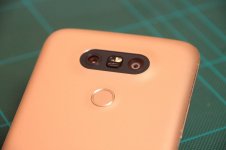
While the phone uses an all-metal body, it doesn’t feel like you’re holding an all metal phone. This is because of LG’s proprietary paint that they’ve used on the device which is also incidentally what hides the antenna lines that’s vital in every phone. As a result, the phone feels warmer to the touch compared to other all-metal smartphones that have simply been anodized. Many people are divided on LG’s use of the paint on the phone, but to be honest it doesn’t bother us too much. The only issue we have with the paint is that it gets dented and damaged far too easily compared to a full metal chassis – our review example had a few very small dings on the top already – another reviewer’s phone that’s been their daily driver for longer had deeper and bigger divets. It’s the trade-off that LG had to make to hide the antenna lines, and not everybody will be happy with it.
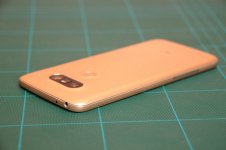
Flip the phone on its back and you’ll see the two rear cameras. Now the G5 isn’t the first to dabble with a twin camera setup, though their implementation is quite different. One camera is used for normally framed photos and uses a 16-megapixel rear sensor with laser AF and OIS while the other is a wide-angle 8-megapixel camera. You’ll also see the power button which also doubles as the fingerprint sensor right below the camera. What’s noticeably absent is the rest of the keys – namely the volume rocker – that’s graced the back of LG’s previous two flagships. That’s been moved to the side to give the phone a more traditional feel in line with other flagship devices.

The biggest hook that LG promises with the G5 is the swappable bottom panel that allows the phone to use specialized accessories. Pressing the button on the lower left side of the phone releases the chin and exposes the removable 2,800mAh battery. Additional modules can be plugged into the device that adds more functionality to the device – the camera module, for example, gives you a traditional camera grip plus manual controls while the HiFi module gives you Bang and Olufsen HiFi audio. If nothing else, it gives you the ability to swap out batteries when your phone runs out of juice, though taking the battery apart from the chin is a nerve-wracking experience since it didn’t want to separate at first no matter how much we pulled. We found that a quick jerk would separate the two, though doing that to a very expensive loaner unit the first time was harrowing, to say the least.
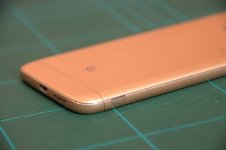
There’s some very obvious trade-offs to this setup – one is that the phone isn’t quite a unibody phone because of the chin that has to separate, and even with the chin on the phone, there’s a noticeable gap on the lower part of the unit. It’s also more susceptible to s***** and H2O than other, fully sealed phones because of its design, so just like gremlins, you need to keep it well away from water unless you want your phone to stop working. The upside is that many of the same features that enamored the G4 to its users – removable battery and expandable storage – is still present on the G5.
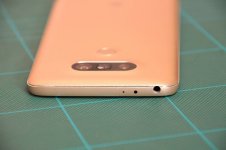
Rounding off the rest of the phone’s physical features is the 5.3-inch, QHD display with on-screen capacitive keys and USB Type-C port on the bottom. The display for the most part is bright, vivid and accurate, though don’t expect AMOLED levels of color saturation here. That can be a good or bad thing, depending on where you stand on the whole color saturated display fence. There’s also the always-on feature that’s also present on the phone of their domestic rival, though the use of an LCD display compared to a AMOLED panel means that the display is turned on a teeny bit – something that AMOLED panels don’t have to do.

Performance fit for a flagship
LG’s G5 was one of the first few phones to be announced earlier this year that came with Qualcomm’s Snapdragon 820 processor. Many doubted that Qualcomm learned their lesson with the 810 when the 820 was announced, but first hand experience (and the sheer number of brands adopting the new SoC) proved otherwise. Anyway, the G5 definitely has flagship level performance, and paired with 4GB of RAM it’s more than capable of running any app smoothly without any issues – it’s a dream to use and won’t leave you wanting.
While the G5 uses Android Marshmallow as its OS, it doesn’t look it. For one thing LG took away the app drawer on the phone, via the LG UX, now at version 5.0. Fortunately, that’s the only major “enhancement” that takes away from Google’s approach to Android. The UI overlay is relatively light and uncluttered, which is a big contrast to the efforts of other manufacturers that take away the app drawer.
Like we mentioned earlier, the G5 has a fingerprint scanner on the back, embedded on the power button. It’s the first time the Korean company used biometric security for a flagship, and it’s a little hit and miss. Yes, it works, but there are times that it just doesn’t want to unlock the phone for some reason, no matter how many times we put our finger on it. The small surface area of the sensor definitely didn’t help things either – chances are you’ll be unlocking the phone via your PIN code more often than the sensor.
While the G5 has a single speaker, it’s quite loud and is distortion free even on higher volumes. LTE performance is top notch, especially while we were using it with Chungwa’s network in Taiwan during COMPUTEX.
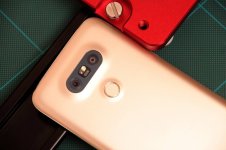
Dual cameras isn’t just a gimmick
Aside from the removable chin, the G5’s biggest feature is the two rear cameras stuck on the back. To outsiders it feels more like a gimmicky feature than something that you’ll use everyday. Well, we’re happy to say that the feature came in extremely handy during the G5’s time with us, as we were able to take photos with different FOVs without shifting position – incredibly useful when you’re out and about sightseeing.

Normal canera

Wide camera

Normal Camera

Wide Camera





The main 16-megapixel shooter is pretty good, easily one of the better cameras we’ve seen in a phone, adept at capturing detail even in adverse conditions. We can’t say the same for the 8-megapixel wide angle camera though, but for what you’re getting the camera is still pretty damn good for what it is.

Battery life is pretty mediocre
The biggest issue that you’re going to have with the G5 is battery life. The 2800mAh battery isn’t up to the task of powering the phone the entire day, especially if you’re a stranger in a foreign land, depending on both Google Maps and Google Translate to navigate around the city. Typical use will get you slightly under 8 hours of useful battery. If you’re using the phone as your primary navigation tool around an unfamiliar city, battery life is closer to around 5 hours. It’s a good thing that the G5 can take extra batteries, because you’re going to need em.
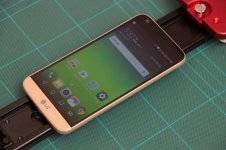
Verdict: A good idea not fully fleshed out
So, at the end of the day is the LG G5 a good flagship phone? Yes, absolutely, though not because of the Korean company’s modular promise. The biggest problem for the G5 is the availability of the accessories and the accompanying “friends” that make the device great. Not all of them are available to buy at launch in the Philippines. Worse still, since the G5’s official launch in April, there’s still no other accessories unveiled for the it besides the ones it launched with. That’s a big problem in a device that’s being touted as the world’s first modular phone – it’s only as good as the accessories that’s available to buy for it.
At the end of the day, the G5 is a great phone. It’s got the hardware chops to stand toe-to-toe with the offerings of other flagships currently in the market today, but as a modular phone, it falls a little short of the mark.
Attachments
-
You do not have permission to view the full content of this post. Log in or register now.